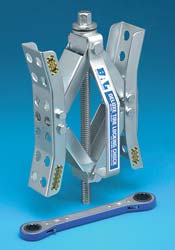Sometimes, if I have the option, I will position the coach so that the front end is on the uphill end - I'll get less waggle inside the coach.
I would not recommend using blocks under the landing gear, unless you first mount the in-between-the-wheels type of locking chock so you "guarantee" the coach isn't moving anywhere.
I bought a 4" X 6" X 8' piece of lumber, and cut it (or you can have it cut) into 12" and 18" long pieces for blocks. I didn't pay for the treated lumber, because these aren't outside all the time. I use the 18" on soft ground - I have buried the 12" ones just from the weight on the front end...
If I had to, I think I could trust piling a 12" on top of an 18" piece if necessary, but I would probably look for a better spot first.

I also have a 2 X 10 X 10 foot board I cut in half to make 2 - 5 foot sections - for use under one set of tires to level left to right when necessary. I made thecut on a 45 degree diagonal, so the tires meet up to a angled board. The only problem with this, is if they both go under the door side tires, that first step is a long ways off the ground!! (Oh well, exercise is good for you, right??) And we also built a platform to serve as an extra step when necessary...
Sounds like a lot of work, but sometimes the extra work for a beautiful "dry camping" spot is well worth it!

